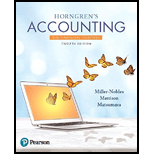
Concept explainers
Introduction:
Perpetual Inventory System: The perpetual inventory system records and updates the inventory after each and every transaction. The inventory balance is updated after each transaction and it is kept up to date at every time.
FIFO method: FIFO Stands for First In First Out. Under this method, the units purchased first are assumed to be sold first and cost of goods sold is calculated accordingly. The ending inventory in the method includes the latest units purchased.
LIFO method: LIFO Stands for Last In First Out. Under this method, the latest units purchased are assumed to be sold first and cost of goods sold is calculated accordingly. The ending inventory in the method includes the oldest units purchased.
Weighted Average method: Under this method, the cost per unit of the inventory is calculated as weighted average cost per unit and the cost of goods sold and inventory is calculated with the help of weighted average cost per unit.
Requirement-1:
To determine: The Perpetual Inventory record for the month of January for Johnson Company using FIFO, LIFO and Weighted average methods
Requirement -2:
To determine: The
Want to see the full answer?
Check out a sample textbook solution
Chapter 6 Solutions
Horngren's Accounting, The Financial Chapters (12th Edition)
- General accountingarrow_forwardUnsure wether the chart is filled out correctly or not. If need changes, please explain why. 1. Record the inventory, purchases, and cost of merchandise sold data in a perpetual inventory record similar to the one illustrated in Exhibit 3, using the first-in, first-out method. Under FIFO, if units are in inventory at two different costs, enter the units with the lowerrr unit cost first in the Cost of Goods Sold Unit Cost column and in the Inventory Unit Cost column. 2. Determine the total sales and the total cost of goods sold for the period. Journalize summary entries for the sales and corresponding cost of goods sold for the period. Assume that all sales were on account. Description Debit Credit Record sale ____Acct Title______ D ___ C _____ ____Acct Title______ D ___ C _____ Record Cost ____Acct Title______ D ___ C _____ ____Acct Title______ D ___ C _____ 3. Determine the gross profit from sales for the period. $ 4. Determine the ending inventory cost as of June 30. $ 5. Based…arrow_forwardLMN Industries reported net sales of $1,750,000 for the year. The cost of goods sold was $1,365,000. a. Calculate the gross profit and the gross profit ratio for the year.arrow_forward
- Summit Industries had operating earnings of $500,000 for the year. The company sold shares of stock it had purchased in another company for $260,000. The original purchase price of the stock was $200,000, and it was held for 10 months before being sold. a. What is the amount of capital gains realized during the year? b. How much total taxable income did the firm earn during the year?arrow_forwardRoslyn's Boutique had an accounts receivable balance of $320,000 at the beginning of the year and a year-end balance of $460,000. Net credit sales for the year totaled $2,800,000. What was the average collection period?arrow_forwardHiarrow_forward
- Summit Industries' activities for the first quarter of 2023 are as follows: January: 4,000 machine hours, $7,800 electrical cost • February: 4,500 machine hours, $8,600 electrical cost • March: 5,200 machine hours, $9,800 electrical cost Using the high-low method, calculate the cost per machine hour.arrow_forwardDo fast answer of this accounting questionsarrow_forwardOption? General accounting questionarrow_forward

 AccountingAccountingISBN:9781337272094Author:WARREN, Carl S., Reeve, James M., Duchac, Jonathan E.Publisher:Cengage Learning,
AccountingAccountingISBN:9781337272094Author:WARREN, Carl S., Reeve, James M., Duchac, Jonathan E.Publisher:Cengage Learning, Accounting Information SystemsAccountingISBN:9781337619202Author:Hall, James A.Publisher:Cengage Learning,
Accounting Information SystemsAccountingISBN:9781337619202Author:Hall, James A.Publisher:Cengage Learning, Horngren's Cost Accounting: A Managerial Emphasis...AccountingISBN:9780134475585Author:Srikant M. Datar, Madhav V. RajanPublisher:PEARSON
Horngren's Cost Accounting: A Managerial Emphasis...AccountingISBN:9780134475585Author:Srikant M. Datar, Madhav V. RajanPublisher:PEARSON Intermediate AccountingAccountingISBN:9781259722660Author:J. David Spiceland, Mark W. Nelson, Wayne M ThomasPublisher:McGraw-Hill Education
Intermediate AccountingAccountingISBN:9781259722660Author:J. David Spiceland, Mark W. Nelson, Wayne M ThomasPublisher:McGraw-Hill Education Financial and Managerial AccountingAccountingISBN:9781259726705Author:John J Wild, Ken W. Shaw, Barbara Chiappetta Fundamental Accounting PrinciplesPublisher:McGraw-Hill Education
Financial and Managerial AccountingAccountingISBN:9781259726705Author:John J Wild, Ken W. Shaw, Barbara Chiappetta Fundamental Accounting PrinciplesPublisher:McGraw-Hill Education





